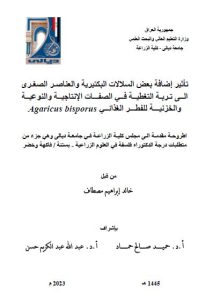Abstract
The aim of this study is to enhance the photovoltaic properties of (ZnO:CuO) films by studying the effect of Mn2O3 contents (0.2, 0.4, 0.6, and 0.8) wt on the photovoltaic properties of unmixed and mixed (ZnO:CuO) prepared at room temperature. The prepared pellets sintered at temperature 750˚C for one hour using electrical tube furnace. Thin films of (ZnO:CuO) with different conctent of manganese(III) oxide were prepared under vacuum of 10-2 mbar on glass subcetrate and p-type Si wafer (100) oriented single crystals by Pulsed laser deposition (PLD) technique using Nd:YAG laser at 1064 nm wavelength, the average frequency of 6 Hz and pulse duration of 10 ns, energy 500 mJ and number of shots 300 at room temperature. The thickness of the films about (200 ±5)nm. The work involved three important parts: First Part: The auto-combustion approach of the Sol-Gel Method was employed in this study to synthesize ZnO, CuO, and Mn2O3 nanoparticles, whereas the applied temperatures were 500 °C. through X-ray diffraction measurements investig of structural properties, the hexagonal wurtzite, monocilinic, and cubic nature of the pure ZnO, CuO, and Mn2O3 crystals structure were established respectively. The crystallite size (D) of the X-ray diffraction pattern for each sample was found by the Scherrer equation. The crystallite size of the pure ZnO, CuO, and Mn2O3 NPs was around 23.31 , 28.7 and 38.8 nm respectivily. Field emission scanning electron microscopy (FESEM) micrographs show that the ZnO particles formed of cubes and a few of them appeared spherically,while the CuO NPs formed spherical shape, and Mn2O3 formed significant clusters of spherical or semi-spherical grains in some areas of the images, indicating an unequal rate of grain growth. The EDS result shows evidence for the existence of the elements Zn, Cu, Mn and O. The energy band gap value of ZnO, CuO, and Mn2O3 nanoparticles was calculated and were 3.02, 1.65, and 1.42 eV, respectively. After that, Prepared ZnO thin films with different concentrations of CuO
(0.2, 0.4, 0.6, and 0.8) wt at RT by PLD Technique. The structural properties of the films have been examined by using X-ray diffraction (XRD) and the results found to be polycrystalline phase transition from CuO monoclinic structure to ZnO hexagonal wurtzite when increasing of CuO content. The results show that crystallite size has decreased while micro strain and dislocations increase with increasing of CuO content. This is because that the atomic radii of CuO particles is smaller than ZnO causes the crystallite size to decrease, suggesting that the dopant atoms are occupying other places inside the ZnO lattice. The AFM measurements results show that the average grain size decreases with decreasing the concentration of CuO which leads to decrease in the surface roughness of the films. This behavior can be explained by the behavior of CuO as an interstitial add with high solubility in ZnO as shown by the XRD results. From FTIR spectra of (ZnO:CuO) thin films, it can be noticed a slight change in the position of the Cu-O peak, 520.74, 520.74, 518.82, and 522.67 cm-1 respectively with increasing CuO content. The optical measurements showed that the relationship between the transmittance value and CuO content is inverse. The films have direct energy gap and its value changed from 3 eV to 2.05 eV when CuO content increases (0.2 to 0.8) wt. The optical constants such as refractive index, extinction coefficient and the dielectric constants were also determined and studied. Hall Effect measurements show that all prepared films are n-type conductivity and change to P-typ at the ratio 0.8wt. The figure of merit was determined in order to achieve the best convergence between two important qualities that can be judged by the absorption and conductivity coefficients and the result was that (0.4) is the best concentration used to prepare our device. Since 0.4 was chosen as the best ratio of the selected ratios for the ZnO:CuO mixture, we mixed this ratio with different ratios of Mn2O3 that we adopted to improve the performance of the solar cell. The XRD show that the diffraction peaks which corresponding to reflection plans of hexagonal ZnO, and monoclinic CuO, decreases gradually with increase cubic Mn2O3 at different concentration of (0.2, 0.4, 0.6and 0.8), respectively, and as Mn2O3 content increases from 0.2wt to 0.8 wt the crystallite size decreased from 26.6 to about 20.6 nm for films prepared at RT. It was noticed that after annealing temperature to 200˚C the quality of the films was improved. Stress and dislocation were also identified. The optical properties revealed that the transmittance decreased with the increasing of Mn2O3 concentration and grew as the annealing temperature rose, shifting at all concentrations towards shorter wavelengths. The direct optical energy gap decreased from 2.35 eV to 1.6 eV with increasing of Mn2O3 content, while the annealing process to 200˚C leads to increase in the value of Eg. Hall effect of the films were studied, and it was found that all the prepared thin films were n-type and the mobility (µ) increases with the increasing of Mn2O3. The concentration and mobility of the carrier decreases as the temperature of the annealing increases. Current – Voltage (J-V) characteristics under dark and illumination showed that the heterojunctions solar cell prepared from (ZnO:CuO)1-X(Mn2O3)X /P-Si gives a short-circuit photocurrent of 2.5 mA, an open circuit voltage of have a good 0.9 mV, and a fill factor of 0.78, corresponding to an overall conversion efficiency of 1.76% at 0.8 concentration of Mn2O3 after annealed at 200˚C.





